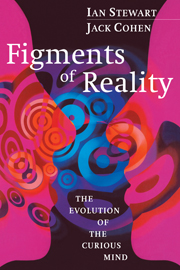Book contents
- Frontmatter
- Contents
- Preface
- Figure Acknowledgements
- Prologue
- 1 The Origins of Life
- 2 The Reductionist Nightmare
- 3 Ant Country
- 4 Winning Ways
- 5 Universals and Parochials
- 6 Neural Nests
- 7 Features Great and Small
- 8 What is it Like to be a Human?
- 9 We Wanted to Have a Chapter on Free Will, but We Decided not to, so Here It Is
- 10 Extelligence
- 11 Simplex, Complex, Multiplex
- Epilogue
- Notes
- Further Reading
- Index
7 - Features Great and Small
Published online by Cambridge University Press: 11 August 2009
- Frontmatter
- Contents
- Preface
- Figure Acknowledgements
- Prologue
- 1 The Origins of Life
- 2 The Reductionist Nightmare
- 3 Ant Country
- 4 Winning Ways
- 5 Universals and Parochials
- 6 Neural Nests
- 7 Features Great and Small
- 8 What is it Like to be a Human?
- 9 We Wanted to Have a Chapter on Free Will, but We Decided not to, so Here It Is
- 10 Extelligence
- 11 Simplex, Complex, Multiplex
- Epilogue
- Notes
- Further Reading
- Index
Summary
JC's daughter Beth, at about the age of eight, was out with her parents in the car and noticed a line of birds sitting on telephone wires - black blobs spaced along a set of parallel lines.
‘Oh, look,’ she said. ‘Music!’
Human minds do more than just recognising various bits and pieces of the universe. They look for patterns in what they recognise, and do their best to understand how the universe works. The universe, however, is very complex: in order to understand it we must also simplify it. Indeed the whole point of understanding something is that you can grasp it as a whole, and that necessitates some kind of simplification or data-compression. An explanation of the universe that was just as complex as the universe itself would merely replace one puzzle by another. In this chapter we shall argue that the brain organises its perceptions of the world into significant chunks, which we shall call ‘features’. As usual we shall take an evolutionary and contextual view of this ability, as well as asking about the internal structure of the brain. Not just ‘how does it work?’ but ‘how did it arise?’ And to get started, we shall take a look at two simpler creatures: the mantis shrimp and the octopus.
Both the octopus and the mantis shrimp are effective organisms, even if they never meet another of their own kind to learn from.
- Type
- Chapter
- Information
- Figments of RealityThe Evolution of the Curious Mind, pp. 165 - 192Publisher: Cambridge University PressPrint publication year: 1997

